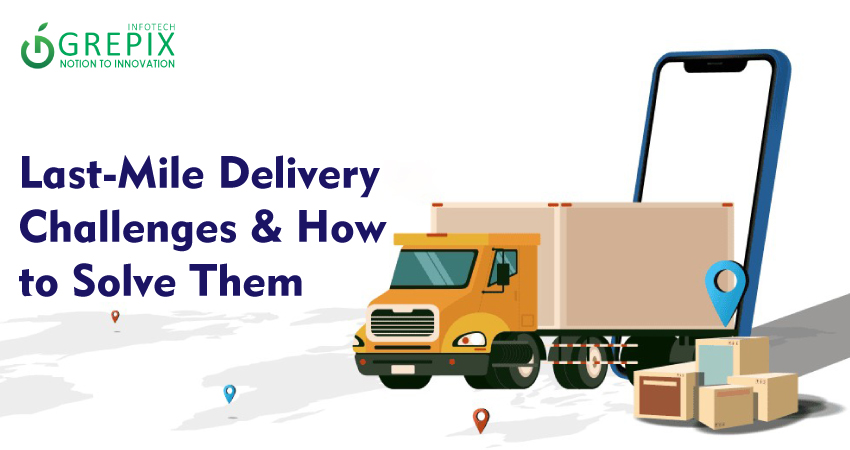Last-Mile Delivery Challenges & How to Solve Them
The last mile of delivery getting goods from a distribution hub to the customer’s doorstep is the most vital and expensive part of the supply chain. In 2025, as ecommerce and on-demand services explode worldwide, this stage presents unique last mile delivery challenges that can make or break brands. With the global last mile market projected to exceed $258 billion by 2030 and 98% of consumers citing delivery experience as crucial for loyalty, mastering last mile logistics solutions is no longer optional. Businesses are investing in cutting-edge delivery optimization apps and deploying last mile technology 2025 to ensure speed, efficiency, and customer satisfaction.
Last-mile delivery is the crucial final leg that determines ecommerce satisfaction and operational efficiency. In 2025, rapid urbanization, rising consumer expectations, and complex urban infrastructure pose even greater last mile delivery challenges for businesses, impacting both costs and customer loyalty. Statistics show last-mile accounts for over 53% of total logistics costs and failed deliveries cost businesses nearly $18 per order. High-traffic urban centers make timely deliveries difficult and expensive, while sustainability and real-time customer demands add further complexity. However, advanced last mile logistics solutions including AI-powered delivery optimization apps, real-time tracking, and autonomous vehicles are rapidly transforming operations for leading brands. This article explores key last-mile challenges, real-life examples, and actionable strategies, from micro-warehousing to smart technology adoption. Equip your business with the knowledge and tools to smoothly navigate last mile hurdles and stay ahead in one of the fastest-growing logistics markets. Read on for solutions and future innovations in last mile technology 2025.
Key Last-Mile Delivery Challenges
High Delivery Costs
- Last-mile delivery accounts for 53% of all logistics expenses a figure rising with fuel prices, traffic, and labor shortages.
- On average, a single failed last-mile delivery costs $17.78, with approximately 5% of attempts failing each year.
- Urban congestion increases fuel and vehicle maintenance costs, further shrinking margins.
| Statistic | Value |
|---|---|
| Share of logistics costs | 53% (last mile) |
| Avg. failed delivery cost | $17.78 / order |
| Failure rate | 5% of all deliveries |
Urban Traffic & Infrastructure
- Traffic congestion in metros like New York, London, Delhi, and Beijing leads to delays and missed delivery slots.
- Poor address accuracy and outdated infrastructure result in delivery route inefficiencies and higher operational costs.
Rising Customer Expectations
- 66% of consumers now demand same-day delivery; many expect real-time tracking and instant proof of delivery.
- Meeting tight time windows and handling last-minute order changes stretch current logistics networks.
- Increased returns in ecommerce add complexity to reverse logistics.
Environmental Sustainability Pressures
- Regulators and consumers require eco-friendly deliveries, pushing companies to adopt green fleets and route optimization to lower emissions.
- Urban pollution rules may restrict vehicle access during peak hours, complicating last mile logistics solutions.
Traffic & Infrastructure Barriers
Urban Congestion & Inaccessible Areas
Urban density increases travel time and risk of failed attempts. Delivery vehicles often struggle with:
- Congested roads during rush hours
- Lack of proper loading zones
- Inaccessible or hard-to-locate addresses
- Infrastructure barriers in older cities
Example:
In 2025, Mumbai reported last-mile delays up 18% year-over-year due to traffic surges, prompting leading courier services to pilot e-bike fleets and micro-fulfillment hubs within city centers for faster delivery turnaround.
Address Accuracy & Last-Minute Changes
- Poorly formatted addresses or missing landmarks account for up to 25% of delivery inefficiencies.
- Dynamic consumer behavior shifted delivery addresses, updated time preferences further compounds rerouting challenges.
High Costs and Operational Inefficiency
Cost-Centric Challenges
- Drivers face unpredictable routes causing high idle time and fuel waste.
- Manual route allocation and outdated mapping systems yield suboptimal delivery runs.
Impact of Cost Drivers
| Cost Driver | Business Impact |
|---|---|
| Failed Deliveries | Extra attempt costs, lost sales, returns processing |
| Traffic/Delays | Longer delivery windows, overtime pay, wasted fuel |
| Route Inefficiency | Higher fleet costs, reduced daily order completion |
| Manual Dispatch | Error-prone routing, inability to scale in peak periods |
Tech Solutions & Real-World Success Stories
The Role of Delivery Optimization Apps
Leading brands leverage tech to overcome last mile delivery challenges:
- Route Optimization: Apps like FarEye, Routific, Onfleet, RouteXL, and NextBillion.ai dynamically plan optimal routes factoring real-time traffic, driver preferences, and service times.
- Real-time Tracking: GPS-enabled apps provide live location as well as estimated arrival times, reducing missed connections and enhancing transparency.
- Smart Address Validation: Advanced apps convert complex addresses into precise coordinates, shrinking failed delivery rates up to 15%.
- Driver Management & Analytics: Apps create driver profiles, monitor performance, and schedule shifts, lifting productivity.
Case Study: Onfleet Success Story
A leading grocery chain used Onfleet to manage a fleet of over 500 vehicles in dense urban zones. By integrating the delivery optimization app, the chain improved on-time delivery by 20%, cut fuel cost by 12%, and reduced customer complaints by 30% within 6 months.
Automation & AI Integration
- Predictive algorithms forecast demand surges, enabling pre-sorting and dispatching from micro-warehouses.
- AI-powered dispatch, dynamic route optimization, and exception management are now the gold standards for operational resilience.
Leading Last Mile Technology 2025 Features
| Technology | Solution for Challenges |
|---|---|
| Predictive AI routing | Real-time traffic, reroutes, optimized drop sequences |
| Real-time GPS tracking | Transparent delivery progress, reduced failed attempts |
| Delivery optimization apps | Driver scheduling, vehicle capacity, instant feedback |
| Smart lockers | Contactless pickup in high-density locations |
Future Innovations: Last Mile Technology 2025
Autonomous & Electric Delivery Fleets
- Growth in electric vans and e-bike fleets, along with rollouts of autonomous robots for short-range urban deliveries.
- Major cities like Paris and Los Angeles are introducing fully electric, self-driving courier vehicles to cut emissions and boost delivery speed.
Micro-Fulfillment & Hyperlocal Delivery
- Retailers deploy micro-warehousing and hyperlocal hubs within city centers, reducing delivery times and costs.
- AI-driven demand forecasting places inventory close to high-demand zones.
IoT & Smart Locker Integration
- IoT-enabled sensors track packages in real time and provide smart delivery confirmations.
- Smart lockers in apartment complexes and public areas allow for convenient, low-contact pickup.
Sustainability Mandates
New emission restrictions and green logistics initiatives are reshaping fleet choices, requiring businesses to align with ESG (Environmental, Social, and Governance) standards.
Conclusion
Mastering last mile delivery challenges in 2025 is the new competitive frontier for brands worldwide. As costs skyrocket and consumers demand near-instant delivery, investing in robust last mile logistics solutions is essential not just for customer satisfaction, but for business survival. Leveraging delivery optimization apps and the latest last mile technology 2025 such as AI-powered route planning, autonomous vehicles, micro-warehousing, and sustainable fleet upgrades can slash expenses, reduce delays, and transform the customer experience.
In this rapidly evolving landscape, operational agility and tech adoption separate leaders from laggards. Forward-thinking businesses are already reaping the benefits in reduced costs, increased loyalty, and greener operations. Are your last-mile logistics up to the challenge?
Take your business to the next level: explore cutting-edge delivery optimization apps and proven last mile logistics solutions. Drive success optimize your last mile for 2025 and stay ahead If this deep-dive helped clarify your approach, share it with peers and subscribe for future insights.
FAQs
1. What is the biggest challenge in last mile delivery in 2025?
The main challenge is balancing rising operational costs with customer expectations for faster, more flexible delivery, especially in urban areas facing congestion and delivery restrictions.
2. How can delivery optimization apps improve logistics performance?
These apps use real-time traffic data, AI algorithms, and dynamic routing to plan the most efficient paths, reduce costs, and boost customer satisfaction by ensuring timely deliveries.
3. What are proven last mile logistics solutions for high-traffic cities?
Deploying micro-fulfillment centers, e-bike or autonomous fleets, and leveraging smart lockers for contactless delivery help solve urban traffic and infrastructure hurdles.
4. How do technology and sustainability fit together in last mile delivery?
Innovative last mile technology 2025 electric vehicles, route optimization, and IoT tracking are designed to lower emissions, meet regulatory demands, and still deliver cost-effective service.
5. What’s the forecast for the last mile delivery market?
Experts project the global last mile delivery market to reach over $258 billion by 2030, driven by ecommerce expansion, new technologies, and evolving consumer preferences.







